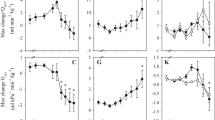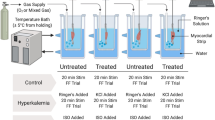Abstract
The coronary circulation first appeared in the chordate lineage in cartilaginous fishes where, as in birds and mammals but unlike most teleost fishes, it supplies arterial blood to the entire myocardium. Despite the pivotal position of elasmobranch fishes in the evolution of the coronary circulation, the determinants of coronary blood flow have never been investigated in this group. Elasmobranch fishes are of special interest because of the morphological arrangement of their cardiomyocytes. Unlike teleosts, the majority of the ventricular myocardium in elasmobranch fishes is distant to the venous blood returning to the heart (i.e., the luminal blood). Also, the majority of the myocardium is in close association with the coronary circulation. To determine the relative contribution of the coronary and luminal blood supplies to cardiovascular function in sandbar sharks, Carcharhinus plumbeus, we measured coronary blood flow while manipulating cardiovascular status using acetylcholine and adrenaline. By exploring inter- and intra-individual variation in cardiovascular variables, we show that coronary blood flow is directly related to heart rate (R 2 = 0.6; P < 0.001), as it is in mammalian hearts. Since coronary blood flow is inversely related to coronary resistance both in vivo and in vitro, we suggest that in elasmobranch fishes, changes in heart rate mediate changes in coronary vascular resistance, which adjust coronary blood flow appropriately.







Similar content being viewed by others
Notes
Mention of trade names or commercial companies is for identification purposes only and does not imply endorsement by the National Marine Fisheries Service, NOAA.
References
Axelsson M (1994) The coronary circulation: a fish perspective. Braz J Med Biol Res Rev Bras Pesqui Med E Biol Soc Bras Biofis Al 28:1167–1177
Axelsson M, Farrell AP (1993) Coronary blood flow in vivo in the coho salmon (Oncorhynchus kisutch). Am J Physiol Regul Integr Comp Physiol 264:R963–R971
Berne RM (1964) Regulation of coronary blood flow. Physiol Rev 44:1–29
Blake DW, Korner PI (1981) Role of baroreceptor reflexes in the hemodynamic and heart rate responses to althesin, ketamine and thiopentone anesthesia. J Auton Nerv Syst 3:55–70. doi:10.1016/0165-1838(81)90030-8
Brill RW, Lai NC (2015) Elasmobranch cardiovascular system. In: Shadwick RE, Farrell AP, Brauner CJ (eds) Physiology of elasmobranch fishes: internal processes. Academic Press, London, pp 1–83
Brill R, Bushnell P, Schroff S et al (2008) Effects of anaerobic exercise accompanying catch-and-release fishing on blood-oxygen affinity of the sandbar shark (Carcharhinus plumbeus, Nardo). J Exp Mar Biol Ecol 354:132–143
Bushnell PG, Jones DR, Farrell AP (1992) The arterial system. In: Hoar WS, Jones DR, Farrell AP (eds) Fish physiology. Academic Press, San Diego, pp 89–139
Butler PJ, Metcalfe JD (1988) Cardiovascular and respiratory systems. In: Shuttleworth TJ (ed) Physiology of elasmobranch fishes. Springer, Berlin, pp 1–47
Cameron JN (1975) Morphometric and flow indicator studies of the teleost heart. Can J Zool 53:691–698. doi:10.1139/z75-084
Chopin LK, Bennett MB (1995) The regulation of branchial blood flow in the blacktip reef shark, Carcharhinus melanopterus (Carcharhinidae: Elasmobranchii). Comp Biochem Physiol A Physiol 112:35–41
Cox GK (2015) The functional significance and evolution of the coronary circulation in sharks. Dissertation, University of British Columbia
Cox GK, Kennedy GE, Farrell AP (2016) Morphological arrangement of the coronary vasculature in a shark (Squalus sucklei) and a teleost (Oncorhynchus mykiss). J Morphol. doi:10.1002/jmor.20543
Davie PS, Farrell AP (1991) The coronary and luminal circulations of the myocardium of fishes. Can J Zool 69:1993–2001
Davie PS, Franklin CE (1992) Myocardial oxygen consumption and mechanical efficiency of a perfused dogfish heart preparation. J Comp Physiol B 162:256–262
Davie PS, Franklin CE (1993) Preliminary observations on blood flow in the coronary arteries of two school sharks (Galeorhinus australis). Can J Zool 71:1238–1241
Davie PS, Franklin CE, Grigg GC (1993) Blood pressure and heart rate during tonic immobility in the black tipped reef shark, Carcharhinus melanoptera. Fish Physiol Biochem 12:95–100
Dowd WW, Brill RW, Bushnell PG, Musick JA (2006) Standard and routine metabolic rates of juvenile sandbar sharks (Carcharhinus plumbeus), including the effects of body mass and acute temperature change. Fish Bull 104:3
Driedzic WR, Scott DL, Farrell AP (1983) Aerobic and anaerobic contributions to energy metabolism in perfused isolated sea raven (Hemitripterus americanus) hearts. Can J Zool 61:1880–1883. doi:10.1139/z83-242
Duncker DJ, Bache RJ (2008) Regulation of coronary blood flow during exercise. Physiol Rev 88:1009–1086
Durán AC, López-Unzu MA, Rodríguez C et al (2015) Structure and vascularization of the ventricular myocardium in Holocephali: their evolutionary significance. J Anat 226:501–510
Farrell AP (1987) Coronary flow in a perfused rainbow trout heart. J Exp Biol 129:107–123
Farrell AP, Graham MS (1986) Effects of adrenergic drugs on the coronary circulation of Atlantic salmon (Salmo salar). Can J Zool 64:481–484
Farrell AP, Steffensen JF (1987) Coronary ligation reduces maximum sustained swimming speed in chinook salmon, Oncorhynchus tshawytscha. Comp Biochem Physiol A Physiol 87:35–37. doi:10.1016/0300-9629(87)90421-X
Farrell AP, Wood S, Hart T, Driedzic WR (1985) Myocardial oxygen consumption in the sea raven, Hemitripterus americanus: the effects of volume loading, pressure loading and progressive hypoxia. J Exp Biol 117:237–250
Farrell AP, Davie PS, Franklin CE et al (1992) Cardiac physiology in tunas. I. In vitro perfused heart preparations from yellowfin and skipjack tunas. Can J Zool 70:1200–1210
Farrell AP, Farrell ND, Jourdan H, Cox GK (2012) A perspective on the evolution of the coronary circulation in fishes and the transition to terrestrial life. In: Sedmera D, Wang T (eds) Ontogeny and phylogeny of the vertebrate heart. Springer, New York, pp 75–102
Franklin C, Axelsson M (1994) Coronary hemodynamics in elasmobranchs and teleosts. Cardioscience 5:155–161
Gamperl A, Pinder A, Boutilier R (1994a) Effect of coronary ablation and adrenergic stimulation on in vivo cardiac performance in trout (Oncorhynchus mykiss). J Exp Biol 186:127–143
Gamperl A, Pinder A, Grant R, Boutilier R (1994b) Influence of hypoxia and adrenaline administration on coronary blood flow and cardiac performance in seawater rainbow trout (Oncorhynchus mykiss). J Exp Biol 193:209–232
Gamperl AK, Axelsson M, Farrell AP (1995) Effects of swimming and environmental hypoxia on coronary blood flow in rainbow trout. Am J Physiol Regul Integr Comp Physiol 269:R1258–R1266
Graham MS, Farrell AP (1990) Myocardial oxygen consumption in trout acclimated to 5°C and 15°C. Physiol Zool 63:536–554
Grant IS, Nimmo WS, Mcnicol LR, Clements JA (1983) Ketamine disposition in children and adults. Br J Anaesth 55:1107–1111
Kent B, Peirce EC II (1978) Cardiovascular responses to changes in blood gases in dogfish shark, Squalus acanthias). Comp Biochem Physiol 60:37–44
Khouri EM, Gregg DE, Rayford CR (1965) Effect of exercise on cardiac output, left coronary flow and myocardial metabolism in the unanesthetized dog. Circ Res 17:427–437
Komatsu T, Singh PK, Kimura T et al (1995) Differential effects of ketamine and midazolam on heart rate variability. Can J Anaesth 42:1003–1009
Lai NC, Graham JB, Lowell WR, Shabetai R (1989) Elevated pericardial pressure and cardiac output in the leopard shark Triakis semifasciata during exercise: the role of the pericardioperitoneal canal. J Exp Biol 147:263–277
Lai NC, Graham IB, Burnett L (1990) Blood respiratory properties and the effect of swimming on blood gas transport in the leopard shark Triakis semifasciata. J Exp Biol 151:161–173
Miyazaki S, Guth BD, Miura T et al (1990) Changes of left ventricular diastolic function in exercising dogs without and with ischemia. Circulation 81:1058–1070
Randall DJ (1968) Functional morphology of the heart in fishes. Am Zool 8:179–189
Santer RM (1985) Morphology and innervation of the fish heart. Adv Anat Embryol Cell Biol 89:1–102
Satchell GH (1971) Circulation in fishes. CUP Archive
Scaramucci GB (1695) Theroremata familiaria viros eruditos consulentia, de variis physico-medicis lucubrationibus juxta leges mecanicas. In: De motu cordis. Apud Joannem Baptistam Bustum, Urbino, Italy, pp 70–81
Short S, Taylor EW, Butler PJ (1979) The effectiveness of oxygen transfer during normoxia and hypoxia in the dogfish (Scyliorhinus canicula L.) before and after cardiac vagotomy. J Comp Physiol 132:289–295
Smith M (1992) Capture and transportation of elasmobranchs, with emphasis on the grey nurse shark (Carcharias taurus). Mar Freshw Res 43:325–343
Speers-Roesch B, Brauner CJ, Farrell AP et al (2012) Hypoxia tolerance in elasmobranchs. II. Cardiovascular function and tissue metabolic responses during progressive and relative hypoxia exposures. J Exp Biol 215:103–114
Steffensen JF, Farrell AP (1998) Swimming performance, venous oxygen tension and cardiac performance of coronary-ligated rainbow trout, Oncorhynchus mykiss, exposed to progressive hypoxia. Comp Biochem Physiol A Mol Integr Physiol 119:585–592
Stensløkken K-O, Sundin L, Renshaw GMC, Nilsson GE (2004) Adenosinergic and cholinergic control mechanisms during hypoxia in the epaulette shark (Hemiscyllium ocellatum), with emphasis on branchial circulation. J Exp Biol 207:4451–4461
Taylor EW, Short S, Butler PJ (1977) The role of the cardiac vagus in the response of the dogfish Scyliorhinus canicula to hypoxia. J Exp Biol 70:57–75
Tomanek RJ (2012) Coronary vasculature: development, structure-function, and adaptations. Springer, Berlin
Tota B (1983) Vascular and metabolic zonation in the ventricular myocardium of mammals and fishes. Comp Biochem Physiol A Physiol 76:423–437
Tota B (1989) Myoarchitecture and vascularization of the elasmobranch heart ventricle. J Exp Zool 252:122–135
von Restorff W, Holtz J, Bassenge E (1977) Exercise induced augmentation of myocardial oxygen extraction in spite of normal coronary dilatory capacity in dogs. Pflüg Arch 372:181–185
West G, Heard D, Caulkett N (2008) Zoo animal and wildlife immobilization and anesthesia. Wiley, Hoboken
Wood CM, Shelton G (1980) Cardiovascular dynamics and adrenergic responses of the rainbow trout in vivo. J Exp Biol 87:247–270
Yaku H, Slinker BK, Mochizuki T et al (1993) Use of 2,3-butanedione monoxime to estimate nonmechanical VO2 in rabbit hearts. Am J Physiol Heart Circ Physiol 265:H834–H842
Acknowledgments
We gratefully acknowledge the entire staff of the Virginia Institute of Marine Science Eastern Shore Laboratory for their continuing and genuine hospitality, and for providing access to capture vessels, fish holding and laboratory facilities. This is contribution 3584 from the Virginia Institute of Marine Science, College of William & Mary. The opinions expressed herein are those of the authors and do not necessarily reflect the views of the US Department of Commerce—National Oceanic and Atmospheric Administration (NOAA) or any of its sub-agencies. We would also like to thank William Milsom, and Erika Eliason for providing critical comments and helpful suggestions on earlier versions of this manuscript.
Grants
This study was supported by a Natural Sciences and Engineering Research Council of Canada Discovery Grant (RGPIN 2015 05059) to APF. APF holds a Canada Research Chair.
Author information
Authors and Affiliations
Corresponding author
Additional information
Communicated by I. D. Hume.
Rights and permissions
About this article
Cite this article
Cox, G.K., Brill, R.W., Bonaro, K.A. et al. Determinants of coronary blood flow in sandbar sharks, Carcharhinus plumbeus . J Comp Physiol B 187, 315–327 (2017). https://doi.org/10.1007/s00360-016-1033-x
Received:
Revised:
Accepted:
Published:
Issue Date:
DOI: https://doi.org/10.1007/s00360-016-1033-x




